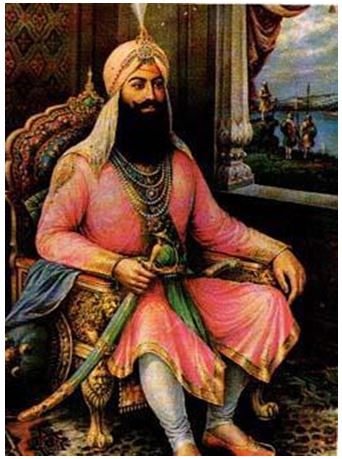JASSA SINGH RAMGARHIA

General Jassa Singh (5.5.1723 – 20.4.1803), son of Giani Bhagwan Singh and grandson of Bhai Hardas Singh, was born at village Ichhogil (district Lahore). At the age of 16, he participated in a battle against the army of Nadir Shah. In this battle his father (Giani Bhagwan Singh) was killed. Zakaria Khan, the Governor of Punjab, in recognition of the services of the family in the battle against Nadir Shah, granted the family the proprietorship of five villages i.e. Vallah, Verka, Sultanwind, Tung and Chib. Jassa Singh and his four brothers (Jai Singh, Khushal Singh, Mali Singh, Tara Singh) divided the estate among themselves. Bhai Jassa Singh got village Vallah. In 1745, he was the major participant in the construction of the fortress Ram Rauni (in the name of Guru Ram Das Sahib, the founder of the city), built near Amritsar. In 1747, his Jatha was given the charge of the fortress of Ram Rauni. Because of this Ramgarhia became a part of his name and his Jatha came to be known as Ramgarhia Jatha. On March 29, 1748, the Sikh army was divided into 11 Misls. Bhai Jassa Singh was appointed the leader of one Misl, known as Ramgarhia Misl, (named after the fortress Ram Rauni, of which Bhai Jassa Singh was the caretaker). Later, he joined as a mercenary with Adina Beg, the Governor of Jullundur. In 1752, he rebuilt Ram Rauni fort. In 1758, he occupied a large area in the districts of Amritsar and Gurdaspur. In 1770, he attacked the hill States, including Kangra, and plundered the royal treasures. He built a fort at Talwara (district Hoshiarpur) where 4000 soldiers could stay. Later, the infighting among the Sikh Misls compelled him to leave the central Punjab. Now, he occupied Hissar. He was one of the Generals who captured Delhi on March 11, 1783. In Delhi, he also participated in building Gurdwaras Sis Ganj and Rakab Ganj. In 1784, he returned to the Punjab and re-occupied his territory. Sirdar Jassa Singh controlled the area of Batala, Kalanaur, Hargobindpur, Qadian, Shahpur Kandi, Ghumman (Gurdaspur) and Maliwal, Urmur Tanda, Sarinh, Gangowal, Miani, Ruhela, Sharif Ganj (Hoshiarpur) and some villages of Amritsar too. The rulers of Chamba, Kangra, Mandi and Nurpur used to pay him a tribute, which amounted to about two hundred thousand rupees. His son Bhai Jodh Singh was not capable. He accepted the supremacy of Ranjit Singh, in 1808. He was a great warrior. He fought several battles against Ahmed Shah and the Moguls. Also see: Ramgarhia Misl.
(Dr. Harjinder Singh Dilgeer)